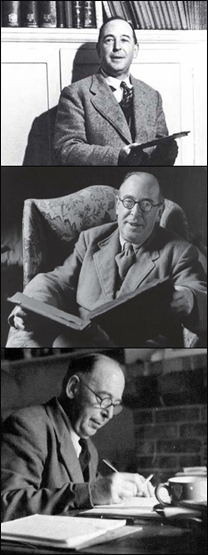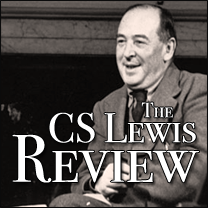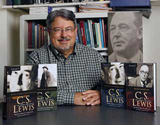
Prince Caspian Resources
The Chronicles of Narnia: Prince Caspian
(Copyright 2010-11 by Bruce L. Edwards. Click here for Permissions information)
[To schedule a presentation or seminar on Narnia, contact me here]
Reading Comprehension Questions
- What are the circumstances in which the Pevensie children return to Narnia? What are the gifts Father Christmas had bestowed upon them in the previous story, and how are they employed here? Why doesn’t Edmund have one?
- Who is ruling Narnia when the children reach Cair Paravel? How has Narnia fallen into this state?
- Who is Prince Caspian, and what role does Doctor Cornelius play in his education?
- Lewis chooses to begin Prince Caspian as a “story within a story.” We learn about what has happened to Narnia a thousand years after their first visit only when the children do, as told to them by the Dwarf Trumpkin, whom Caspian has sent to meet them in anticipation of their return. Is this an effective way to bring us into the plot? Why or why not?
- How does Lucy’s strong faith in Aslan once again manifest itself in this tale? Why are her brothers and sister so slow to respond in trust?
- The renegade dwarf, Nikabrik, refuses to align himself with Caspian’s cause and with Aslan; what is the source of his alienation and hopelessness? What is his final end?
- All’s well that ends well: How are Miraz and the Telmarines finally defeated? What is the fate of the Telmarines?
- What do we find out at the story’s climax about Caspian’s true lineage? Why is it important to our overall understanding of Narnia’s destiny?
Thematic Discussion Questions
- There is no wardrobe in this Narnian episode, but a train station. How does this new way into Narnia affect the way you see its “magic”? Do you miss Professor Kirke?
- How could Narnia have changed so much in the time since Peter, Lucy, Susan, and Edmund were first there? What are the reasons for these historical circumstances? Has it happened in our civilization too?
- Aslan, fearsome and grim throughout much of The Lion, the Witch, and the Wardrobe, does seen more playful and even exuberant in Prince Caspian, especially in his relationship with Lucy. What accounts for the change in his disposition? Is he just as majestic as before but more tender? How and why does he rebuke Lucy, nonetheless, for her delay in obeying?
- What happens to a person, a neighborhood, a nation when basic belief falters and one’s forgets his or her roots and foundation? Is Aslan “missing” or have the Narnians banished him?
- When the Telmarines are conquered, Aslan has them pass through “a door in the air.” Where does this journey take them? What is the significance of this “door”?
- In Surprised by Joy, Lewis cited several people—some friends, some literary influences—who are instrumental in his eventual conversion. If you know this work, choose one of these influences and explain their contribution to his new perspective that permits his embrace of Christianity.
- The concept of “chronological snobbery,” first mentioned in Surprised by Joy in Chapter 13, and echoed as a key theme in Prince Caspian, focuses on the need to resist the tendency to automatically discount truths that originate in the past. Is the reverse true? Is it ever the case that we miss opportunities for growth and deeper understanding because we reject the present?
Personal Reflection Questions
- Prince Caspian learns from his tutor, Dr. Cornelius, some surprising news about his family heritage and his current circumstances. Have you ever had a surprising discovery about your own past life—revealed to you by a parent, trusted mentor, or friend? How has that shaped your outlook on how your life has unfolded? Would you rather not know? Write a journal entry that explores this theme. How does God use those surprises or unwelcome news items?
- Nikabrik’s attitude, “I’ll believe in any one or anything,” is pragmatic and sounds resourceful, but his “situational ethics” turns out to be his undoing. Why was it so hard for him to believe in anything? Why is it hard for people you know to put their trust in God? Is there any good to come of doubt? Why or why not?
- Think about the ways the movie of Prince Caspian may depart from Lewis’s original work. Does any of it bother you or weaken the story? Does anything that is a new addition strengthen it? WHy or why not?
What We Learn: Image, Character, Theme
Image
- The Ruins of Cair Paravel: When the children arrive back in Narnia, their old castle is in such disrepair that they do not recognize it, and it becomes a system for the decadence and delay of the entire Narnian world.
- Black Magic: Nikabrik’s advocacy of the use of black magic shows that he is in league with the wrong forces—his view that evil can serve the ends of what is good is a distortion of Narnian ethics. His ignorance of and disbelief in Aslan leave him defenseless.
- A Door in the Air: The Telmarines and the Pevensies all return to the world of Humans this way; it is a way out of Narnia, but not a way back. It is one-way ticket.
- Checkmate: The chess term Lewis uses in describing his conversion in Surprised by Joy. God is the master chess player.
Character
- King Miraz: Like the plotters and schemers in Shakespeare’s tragedies, Miraz is a weak-willed tyrant who comes to the throne through treachery against Caspian’s father.
- Caspian: Prince Caspian is a callow youth who must become acquainted with the true heritage of his own household and of Narnia to ascend to the kingly role for which he is destined. Like the many young kings depicted in the Bible and in many other world cultural narratives, he is wise beyond his years and yet his greatest trait is his humility.
- Reepicheep: This chivalrous mouse, who takes a more central role in The Voyage of the “Dawn Treader”, invokes a theme common in many fairy tales: that strength and courage are not measured by the stature of the individual but the size of her or his heart.
- Trumpkin: As a trustworthy and valiant dwarf, Trumpkin is a counterpoint to the faithless, dour Nikabrik, who is unable to overcome his doubt and ignorance to embrace the truth of Narnia’s glorious past and promising future.
Themes
- “Aslan is bigger the older we grow”: Lucy finds that as she has matured in her own faith, so Aslan has grown visually in size and authority. He reminds her that he is, in fact, not larger than before, and that his presence in her life is greater by virtue of her deeper faith.
- “Old truths don’t lose their value because they are old”: This is an important theme throughout the Chronicles—one must not judge the validity and truth of a statement by “when” it first originated. Dr. Cornelius, Caspian, Trumpkin, Reepicheep, all must fight through their skepticism in order to accept as true the “old” belief that Aslan exists and Narnia’s future is dependent on this “ancient” knowledge. This is a fictional treatment of the challenge “chronological snobbery,” which Lewis discusses in Chapter 13 of Surprised by Joy.
- “Returning to Narnia is not guaranteed”: We learn at the end of Prince Caspian that this would be Peter and Susan’s last journey to Narnia. While shrouded in mystery, Peter accepts this as the will of Aslan, and the implication is that they have served an apprenticeship in Narnia that has now prepared them for a permanent return to the Land of Humans. Peter does appear again in a vision to Tirian, a character in The Last Battle.



